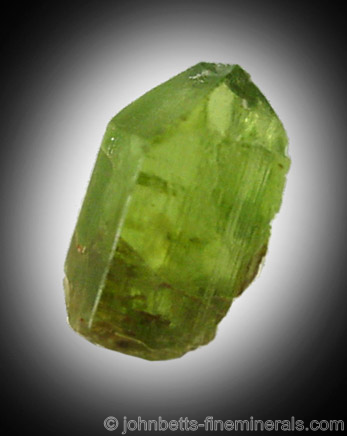The olivine Mineral Series

Olivine is one of the most common minerals in the earth, and is a major rock forming mineral. Despite this, good specimens and large crystals are uncommon and sought after. Only few localities yield large examples of this mineral, although small and microscopic grains are found worldwide. Olivine is also found in meteorites, and large grains have been reported in many of them.
Olivine is not scientifically classified by the IMA as an individual mineral species, but is rather recognized as a mineral group with the Forsterite and Fayalite end members. Fayalite and Forsterite create a solid solution series, and most specimens identified as Olivine fall somewhere in between this series, almost always leaning more towards Forsterite with a greater content of magnesium. Pure Forsterite is uncommon, and pure Fayalite is very rare.
Chemical Formula
The Olivine group is composed of the following primary members:
Forsterite: Mg2SiO4
Olivine (Chrysolite): (Mg,Fe)2SiO4
Fayalite: Fe2SiO4
The intermediary variety, Olivine, is not scientifically recognized as a separate mineral, but is nevertheless well-established.
The mineral Tephroite (Mn2SiO4), which many consider a member of the Olivine group, forms a series with Forsterite.
There are other rarer members of the Olive group such as Tephroite.
Color
Forsterite and Olivine can be olive-green, light green, dark green, yellow-green, yellow-brown, and brown. Rarely white, gray, or orange. Pure Forsterite is colorless, but this is extremely rare. Fayalite is usually yellow-brown to brown.
Crystal System
Orthorhombic
Properties
Streak
Colorless |
Hardness
6.5 - 7 |
Transparency
Transparent to translucent |
Specific Gravity
3.2 - 3.4 |
Luster
Vitreous |
Cleavage
2,1 ; 3,1- forming a 90º angle |
Fracture
Conchoidal |
Tenacity
Brittle |
Crystal Habits
Most often as rounded grains, in dense aggregates of grainy crystals, as fractured masses, and as rounded waterworn pebbles and grains. Large crystals, which are prismatic and stubby, are uncommon except at a few select localities. Crystals often have rounded faces.
Varieties
-
Describes a yellowish or yellowish green form of Olivine. May also be used as a synonym for Olivine, or to describe the intermediary member of the Olivine series. Chrysolite is also an old name occasionally used to describe yellow, transparent Chrysoberyl.
-
Solid, grainy masses of Olivine. Usually classified as a rock.
Uses
Olivine has several industrial uses. It is used as a flux for steel production, and is also an important ore of the metal magnesium.
Peridot, the transparent olive-green to yellow-green variety, is a well-known gemstone. It is very popular in jewelry, and is used in many jewelry items including rings, bracelets, necklaces, and earrings. Peridot is the birthstone for the month of August.
For additional information, see the gemstone section on Peridot.
Noteworthy Localities
The most classic source of gem Peridot is St. John's Island (Zagbargad) in the Red Sea, Egypt, which once produced outstanding large crystals. This deposit has produced Peridot since ancient times and has long since been exhausted. The largest Peridot crystals now come from Pakistan at Sapat Gali, Mansehra, in the Kohistan District. Large gemmy Peridot crystals also come from Mogok, Burma (Myanmar).
Other significant worldwide deposits of Olivine include the Eifel Mountains of Germany; Monte Somma, Vesuvius, Italy; Mt. Briançon, Langeac, Auvergne, France; the Åheim Quarry, Møre og Romsdal, Norway; Taganana, Tenerife, Canary Islands; and Katukubura, near Kolonne, Sri Lanka.
In the U.S., the most significant and well-known deposit, which has produced excellent gem Peridot, is the San Carlos Indian Reservation, in Gila Co., Arizona. Two other important Peridot localities are Buell Park, Apache Co., Arizona; is the Kilbourne Hole, Doña Ana Co., New Mexico. The Day Book Quarry, in Burnsville, Yancey Co., North Carolina, has produced some good Olivine specimens. In Canada, large Olivine crystals come from the Parker mine, Notre-Dame-du-Laus, Québec.
Distingushing Similar Minerals
Tourmaline - Different environment and crystal structure.
Apatite - Lower hardness, different crystal habits.
Garnet - Occurs in different crystals, lacks cleavage.